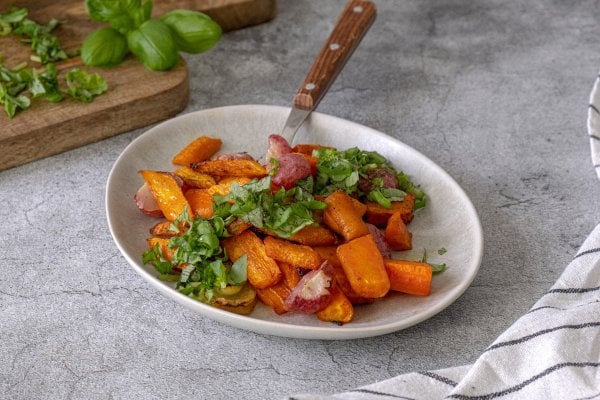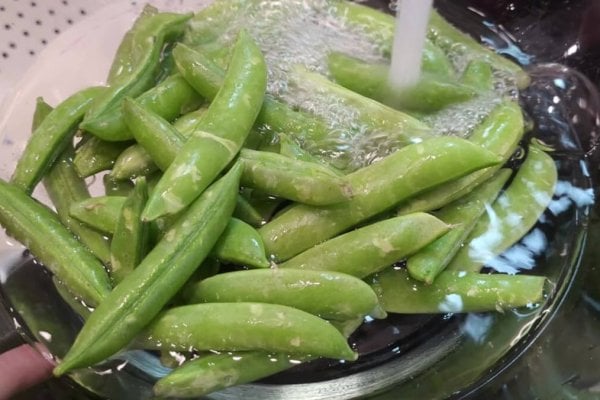






When the world seems unstable, it’s time to take stock of your food supply. That way, no matter what’s going on, you know you can always feed your family a good quality meal. Here are the seven pantry staples I always have on hand.

We’re big proponents of having a well-stocked, organized pantry and building up your long term food supply. Not only is having food on the shelf as good as having money in the bank, but it will give you peace of mind knowing you’ll be able to feed your family well, even in stressful or difficult times.
(Read this post for 9 emergency preparedness tips to be ready for anything.)
In this post, we’re covering the basic pantry staples we’re never without. If you follow these basic principles, you can rest easy knowing you’re prepared and well-stocked, even if the grocery store shelves are stripped of certain food items as they were this past year.
When keeping your pantry stocked with food, there are a few principles to remember…
Only Store What You Will Eat
It can be tempting to buy a bulk container of food when it’s a great deal at the store, but if your family will never eat it, then you’ve wasted money and not actually gotten ahead.
Instead, wait for the great deals on the food you and your family love, then stock up on those items. It’s better to have 50 cans of your favorite soup than it is one tin of anchovies you’ll never eat (although we happen to love anchovies!).
Stay Ahead of Your Consumption
Always stay ahead of your consumption by planning to shop for extra of your pantry staples. When you grocery shop for the week, toss a couple extra bottles of oil, pasta sauce, or a few bags of beans into your cart to start stocking your shelves.
You don’t have to go out and bulk buy everything all at once, this can be both overwhelming and cost-prohibitive. It’s much easier to build up your food supply a little each week.
Before you know it you’ll have a well-stocked pantry you can be proud of and take comfort in.
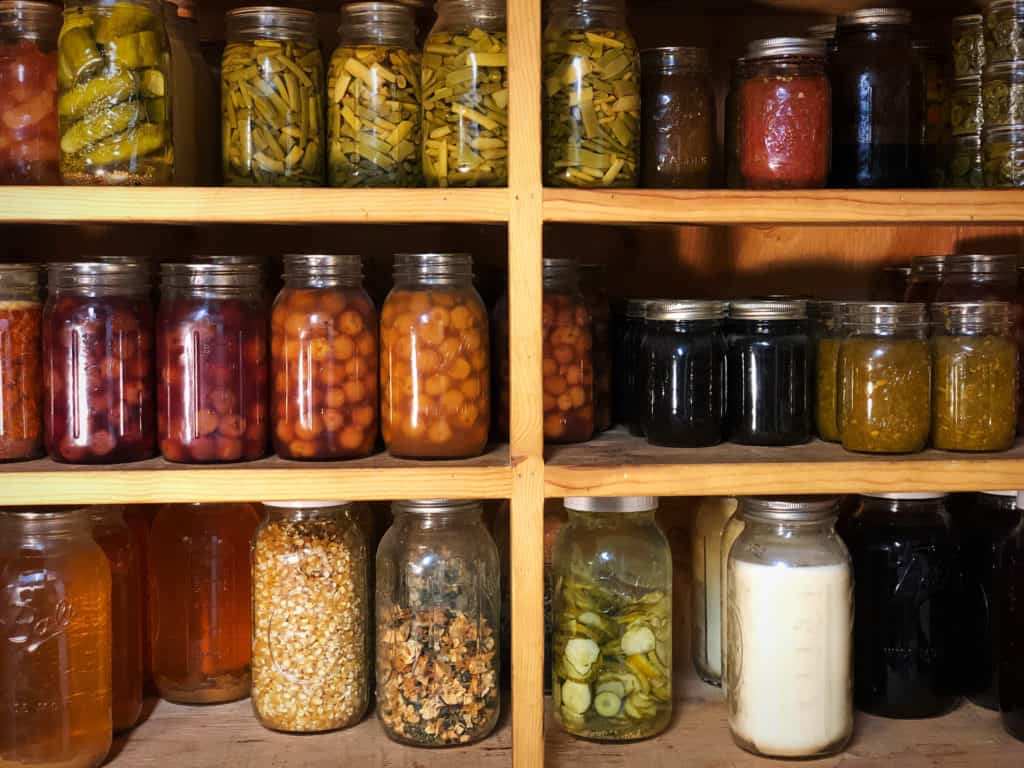
Know How You’ll Store Your Food BEFORE You Buy
Consider storage first! Ask yourself some basic questions such as…
- Do I have space for this?
- Is this item shelf-stable as is, or does it need a different container?
- Do I need to break the container down into manageable or useable sizes?
Knowing how you’re going to store what you buy before you buy it will help save a headache (or wasted food) later on. If you buy a large bag of flour, but don’t have the ability to store it correctly, that flour could go bad, get bugs in it, or collect moisture.
Read this post for more info on how we bulk buy and build up our long-term food storage.
Pantry Staples List – Items To ALWAYS Have On Hand
Here are the seven pantry staples I always have on hand. These are items that I set a base amount and never go below. If we get down to one five-gallon bucket of grain, we replenish our supply as if we were out!
- Grains & Legumes
- Fats & Oils
- Sweeteners
- Baking & Pantry Staples
- Meats & Proteins
- Fruits & Veggies
- Convenience Foods
- BONUS: Comfort Foods
Grains & Legumes

I always have grains and legumes on hand and I buy them in bulk because they store really well. I can save money by buying these items in bulk and I don’t have to worry about the food spoiling with a short expiration date.
Then I always have a variety of dried beans stored in buckets or jars because they make a great complete meal that will keep everyone full and happy. I often can black beans to make them readily available for those nights you need a quick meal. We love all kinds of beans, but some common beans are pinto, kidney, and black beans. Buy what your family loves best.
Wheat (or wheat berries) is a pantry staple I’m never without. With it you can mill your own flour or cook it whole. If you’re going to be storing grains, we recommend looking into buying a home grain mill.
I can quickly whip up some whole wheat scones, country whole wheat biscuits, or feed my sourdough starter. We love buying in bulk from Pleasant Hill Grain.
Two more staple items are oats for oatmeal and white or brown rice.
Fats & Oils
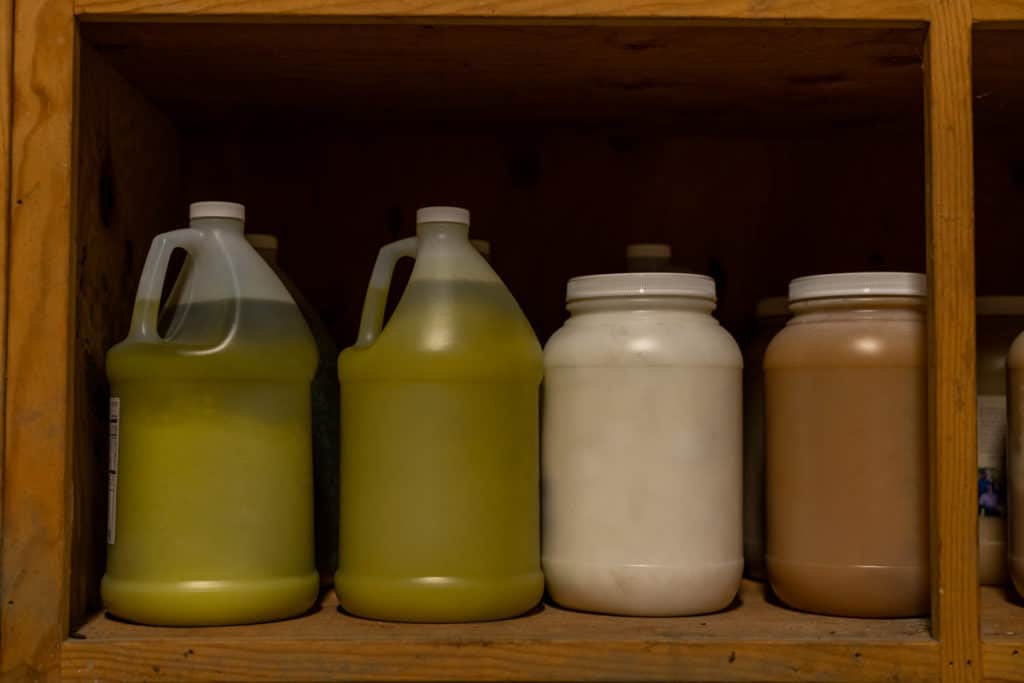
Fats and oils are typically one of the first items to disappear off grocery store shelves in an emergency. They’re great items to stock your pantry with because they add flavor and essential fat that will both give you energy and help you stay full.
My favorite oils are homemade butter, which we make all throughout the summer and store in the freezer, plus olive oil, lard, and coconut oil stored in large gallon buckets. Avocado oil is another healthy oil option.
If you are looking for a sustainable oil source, then consider pressing your own nut and seed oils. The beauty of having your own seed and nut press is that you are never storing the oil, instead you are storing seeds and seeds have a much longer shelf-life than oil.
Sweeteners

Sweeteners also disappear quickly off the grocery store shelves (and even our own home shelves), so keeping extra stocked up is a really smart decision.
Not to mention, having sweeteners means you can make up a delicious treat to bring comfort in the midst of a calamity, and that helps alleviate a little bit of stress for everyone.
If regular sugar becomes scarce, consider stocking other forms of sweetener such as molasses, brown rice syrup, and even monk fruit or stevia.
Baking & Pantry Staples
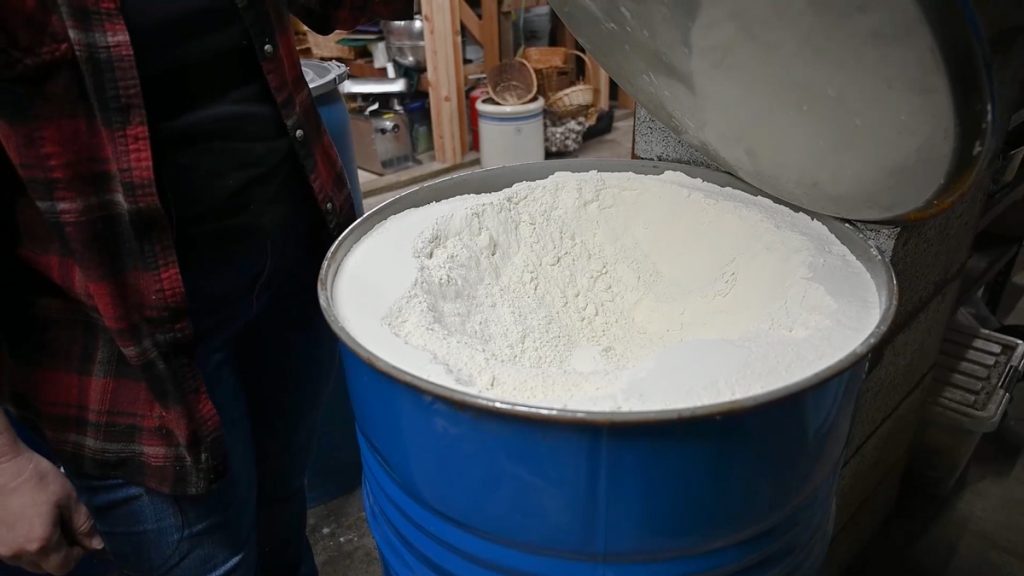
Some basic baking and pantry staples I like to stock up on are things like vinegar for salad dressing, baking soda, baking powder, and salt for baking. Basically, all the staples to continue baking regular food for your family.
One of my favorite places to stock up on pantry staples is Azure Standard. Homesteading Hack: If you’re a first-time Azure Standard customer, use coupon code “HOMESTEADINGFAMILY15” at checkout for 15% off your order of $100 or more!
For us, this also includes things like dried herbs (learn how to dry your own herbs here), and any other seasonings or spices your family uses often. We always have homemade garlic salt, homemade onion powder, homemade celery salt, and some other favorites on hand.
This may look different for you, so consider what you cook and bake at home on a regular basis and what common ingredients those items require.
Meats & Proteins
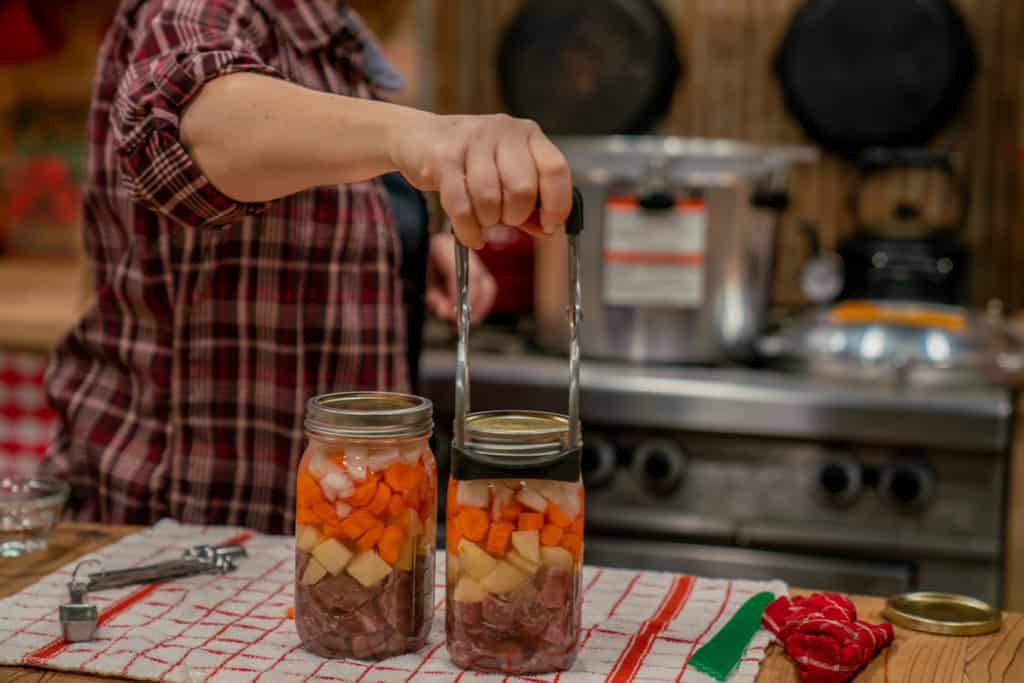
I like to keep a variety of meats in multiple forms. We have frozen meat in the freezer, canned meat on the pantry shelf, and even dehydrated meat.
Eggs are another protein item we like to store. You can preserve eggs by water glassing, we like to freeze eggs in ziplock bags, but one of our favorites is pickling eggs to store in the pantry. This year we have even experimented with freeze drying eggs.
Fruits & Veggies
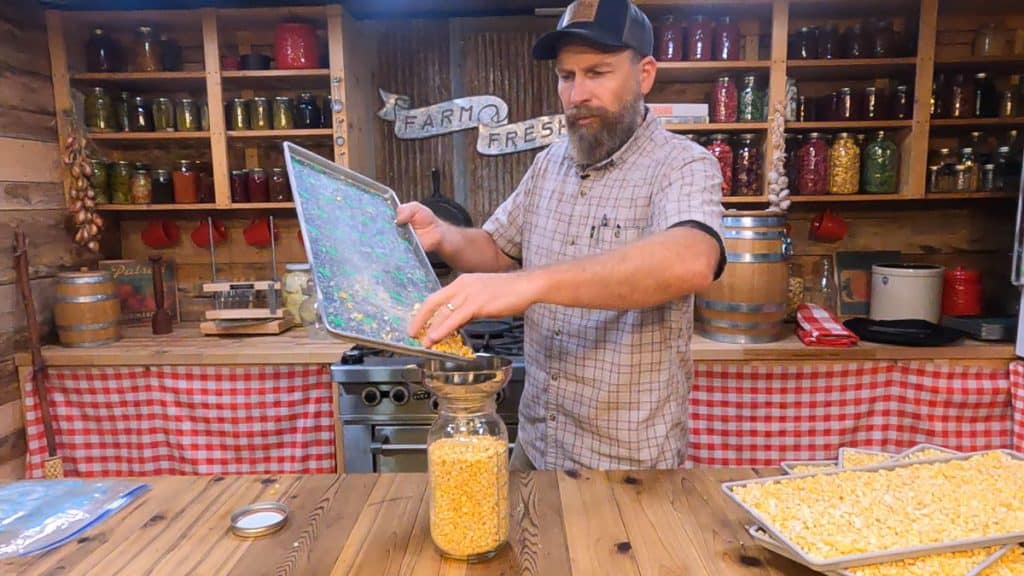
Fresh fruits and veggies are the best way to go, so our meal planning revolves around eating seasonally. Unless you can garden year-round, you won’t always have access to them so you’ll want to keep some canned, frozen, dehydrated, and even freeze dried fruits and veggies on your pantry shelf (like these canned cherries).
We love having fruit-bearing trees on our property and we’re continually doing our best to prune and maintain our fruit trees for the best production. We definitely recommend planting some if you have the space to do so as this is the most cost-effective way to get stored fruit on your pantry shelves.
Convenience Food
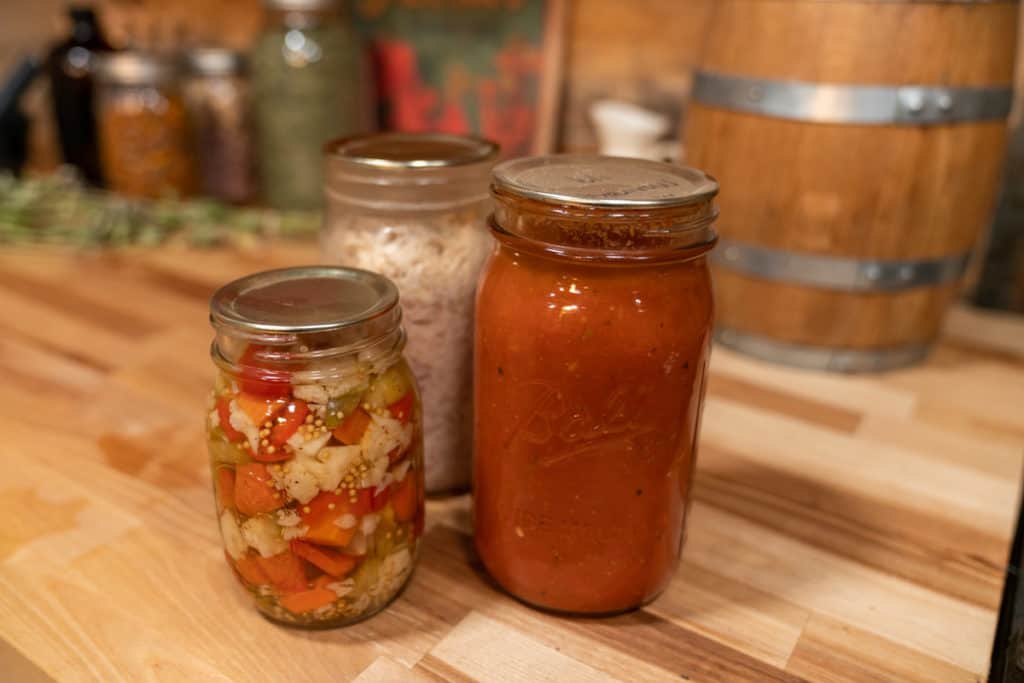
Last, but certainly not least, are convenience foods. We like storing quick and easy meals such as canned beef stew, white bean chicken chili, or even freeze dried chicken pot pie that we can heat and eat.
Another favorite is homemade canned tomato soup (which you can learn how to make here for free!). Something else we do on a regular basis is to cook once and eat twice. When you cook a meal you can double it up and freeze one for later.
Also, having simple shelf-stable pantry meals like dry pasta and a jar of marinara sauce or macaroni for instant pot macaroni and cheese is a good thing to have on the shelf just to keep everyone fed and happy in a pinch.
Comfort Foods

Coffee anyone?
A bonus pantry staple that we just had to mention are comfort foods. They don’t necessarily need to be coffee or sweets (although having a well-stocked coffee supply, especially green coffee beans for roasting coffee at home, plus a stash of chocolate for mom is a must in our home!), so consider the items that bring you comfort and keep some extras on the pantry shelf, in the freezer, or wherever makes sense.
The biggest thing to remember in stocking up your pantry is that it doesn’t have to happen overnight, but it should happen.
If space is an issue, consider having a few small totes you can store in a back closet, under a bed, or even in the garage (as long as the temperature isn’t an issue).
Get a plan, make a list, and take it one grocery trip at a time!
Other Posts You May Enjoy
- How to Beat Inflation at the Grocery Store
- My Secret to Running a Productive Household
- Building Up a Well-Stocked Pantry
- Tips for a Busy Preservation Day
- How to Get 3 Home Cooked Meals on the Table Every Day
- My Preserving Year-at-a-Glance
- 3 Things You Must Do To Increase Self-Sufficiency
Josh: Hey guys, this is Josh.
Carolyn: And Carolyn.
Josh: ... with Homesteading Family, and welcome to this week's episode of the Pantry Chat, Food for Thought.
Carolyn: This week, we are talking about filling up your pantry and stocking up your pantry, so we're going to be going over the basics.
Josh: That is a good thing to be doing right now when it's winter. So there's the harvest and there's things to put up. And too, we are in a highly inflationary environment with a lot of other uncertainties and so-
Carolyn: All sorts of things going on.
Josh: Having a well-stocked pantry is just a very, very good thing.
Carolyn: Yeah. And for those of you guys watching on video, sorry the light is awful.
Josh: We're stocking our pantry, which means that the preservation kitchen is in high use, the freeze dryers are running, there's other preservation going on. And so the house is busy, we had to find a spot outside here that had a little bit of sunshine because it's getting chilly. But obviously, so for those of you that can see us, light's a little off today. But it'll be good.
Carolyn: We're going with it. All right. Well, welcome to fall. We've been in fall, but it really feels like fall right now. And I think it's because we're starting to do the freeze has to come sometime really soon scramble.
Josh: It's actually kind of late. We're actually having a little bit of an Indian summer. And so it's actually not that cold for October, but it is chilly sitting out here and we're starting to feel the push. I saw a big old huge basket of peppers come in here just a little bit ago from the girls. And you were talking about the freeze that is on the forecast. And so now we're into the push, get everything in before the freeze comes. Besides the root crops, they'll be able to handle... And actually some of them will get a little better with some cold weather.
Carolyn: Yeah, absolutely. But we have been pushing those grapes. They have been trying, trying, trying to ripen. There's so many grapes on the vine, so we're kind of pushing them to the last minute. They've actually been covering them every evening in plastic, some greenhouse plastic, to be able to push them further and get a little bit-
Josh: [inaudible 00:02:08] frost.
Carolyn: Yeah, just ripen a little bit. So early next week I think we're going to be scrambling to harvest and deal with all of the grapes after we've given them every last moment available to ripen. But I don't think we're going to get past next week.
Josh: Yeah. So it's on. Harvest season is on, game is on.
Carolyn: Yeah.
Josh: Yeah.
Carolyn: It's good. It's good.
Josh: That's a little bit what's going on, we kind of eased into it here, but what's up with you specifically?
Carolyn: I have to share the issue of In the Homestead Kitchen magazine, here we go, is out.
Josh: Good. Beautiful.
Carolyn: It's ready.
Josh: These things are so beautiful.
Carolyn: They really are. And again, I have to say, this is the only physical copy in existence. If you jump into subscribing to the magazine, it's a monthly magazine. It is digital right now. We are slowly working towards plans towards hopefully taking it-
Josh: That's been the goal for a long time.
Carolyn: I'm not promising anything yet.
Josh: Well, we're headed that way.
Carolyn: But you can see it is beautiful all the way throughout. Tons of recipes. This month we're centering on something we're going to be doing a lot of in the kitchen next week, what to do with your unripe and green tomatoes. So we have a whole lot of great recipes in there. So make sure you check this out. I'll put the links down in the description. If you're not already a subscriber to the In the Homestead Kitchen magazine, you're going to want to check it out. There are actually, I think I just looked and there's nearly 4,000 subscribers to the magazine right now. So you guys will be in good company if you jump in. Enjoy.
Josh: Well, and for those of you that would love to see it in print, the larger we can grow the subscription base, the closer we get to being able to put it into print. Print's obviously a lot more expensive and takes a lot more work and a bigger team. And we'd love to be able to do that one day, and you guys supporting the magazine helps it get there.
Carolyn: Absolutely. So anyways, we've been wrapping that up. And then just the harvest season, really. We've been doing a lot of harvesting, like you said, the peppers came in yesterday and today, so we have found our absolute favorite pepper preservation method now is to dice them with onions, leaving them both raw, the onions and the peppers raw, and freeze drying them. They just are phenomenal for quick grabbing and throwing in just about anything, topping pizzas, all sorts of stuff. And it's just been a great way to go with the peppers.
Josh: Easy to preserve and easy to use that way. Hey, just I got to say it now because I'm going to forget. I think you need to check out the onions that have been drying for a while. I think we need to get those in here pretty quickly.
Carolyn: The onions are up in the barn in their curing station right now, so that they will be all ready to bring in and get in crates and get into storage for the year. So it's about time to get them in.
Josh: [inaudible 00:05:12] about time. Yep. Yeah, they're starting to fall on the ground.
Carolyn: The garlic came in the other day. We went through those and got the garlic all stashed away. So lots of good stuff.
Josh: Yeah.
Carolyn: Yeah. Good. What about you? What have you been up to?
Josh: Oh, you know. Just harvest and winter prep. We got all of our grain in, and usually I buy all the grain for the winter, and in the spring this year I purchased all of the grain for the year, I think, that we're going to need. Even our meat layers, which generally I try not to do because the quality does degrade sitting there. But I'm definitely concerned-
Carolyn: Our meat chickens.
Josh: Our meat chickens for next year. So we've actually bought all of the grain for them, at least what we think we're going to do next year. And I usually wouldn't do that, but I'm just really feeling the need to get ahead. I just feel the environment that we're in, that money sitting there is better than money in the bank.
Carolyn: Money sitting in the grain sack.
Josh: In the grain sack, in the hay sack, in the food barrels. Lots of places like that and the animals on the hoof. I think that's a real good place for our money right now. So really a lot of strategies like that, just really thinking about gearing up for winter prep but kind of extending it and looking a little bit more into longer term crops here both for winter and in the next year to just build in a little bit of security and get some of that money out of the bank and onto real things, real assets right here on our property.
Carolyn: And a key to doing this, I know we've talked about this a bit and we'll probably talk about this a little bit more in today's topic, is make sure you're stocking up on things you're going to use, and then you're not going to lose out because you're going to use it eventually one way or another. So it's not like, "Oh, go buy all that freeze dried food that you'll probably never use and just stash it down there." In that case, that's probably not a great use of money and it's not necessarily better money there than in the savings account, although there could be scenarios where it would be. But if you're going to use it anyways, you're just buying it early when it's cheaper.
Josh: Yeah. And real quick, I know this can be difficult for people to do. You hear that and like, "Oh yeah, well, okay, you must have a great bank account or whatever to be able to stock up like that." And there was a time when we lived paycheck to paycheck, hand to mouth, and it took a shift in mentality and it has taken time to work up to being able to buy bulk like this. But the strategy is just slowly shifting and taking little steps to get from week to week to month to month, and then month to quarterly, and then month to six months. And it takes, because it's very hard to do all at once obviously, but it doesn't take more money. That's definitely helpful.
But it takes changing how we use our money in whatever form it's coming in to allocate it differently, and maybe pulling back on things in the near term so that we can start to get ahead and make larger purchases that are in bulk that we can then get a better price on. So just a little tip there for those of you are wondering how do you get there? How do I do that? Because you're right, you can't just go from where you're at maybe to buying a year's worth of something. You might be able to buy a year's worth of one something, but to do this consistently, it does take a shift in money management more than just making more money.
Carolyn: Yeah, it absolutely does. And the good news about it though is that as you start buying bulk, you usually do save money. So as you take those steps, kind of slowly moving to buying a month's worth, you end up saving money that helps you get ahead faster. So that's a really good part of it, but it's really those initial moments of how do I go from going to the grocery store and buying what I need for the week to buying what I need for the month? Those are the painful moments.
And those you may have to simplify your diet for a few weeks, simplify something to save a little money so that you can do that big stock up where you are saving money. Now of course, the big caveat to this is once you get that big stock up, don't go spend all the money you just saved. You have to put that towards your groceries the next time so that you're getting ready to stock up again for the next month. But yeah, it's a good way to go once you get over that initial hump.
Josh: Well, it's interesting, you say that and it kind of makes me think of just investing in compound interest really. It kind of works like that compound interest. In the beginning it's such a tiny amount, it doesn't seem like much. But you keep adding to it, you keep building on it and it grows and then it starts to get momentum and then the return that it gives you and the growth that you have starts to accelerate. But it does take a while and it takes that discipline of just doing a little bit at a time, day by day, week by week. But it works a lot like that. And then eventually you get that momentum going, could mean a larger investment account or bank account or whatever that you're earning interest on, though that's hard to do with a bank account these days.
Carolyn: Well, and then it becomes significant, it becomes a significant amount, so that's a good way to go.
Josh: Good stuff. We should probably do a whole Pantry Chat on that, but that's not the topic of today. Hopefully that's helpful to some of you, though. Let's get into a question of the day so that we can then tackle stocking up the pantry.
Carolyn: Good.
Josh: Yeah. Let's see, this one looks like it is for... Is this for you or for me?
Carolyn: I think it's for both of us.
Josh: Okay.
Carolyn: Go for it.
Josh: Okay. I'll read it. Shannon Coots on the Pantry Chat Q&A: "Can you use turkey heads and feet the same way as chickens to make the broth?" I love it. I love your thinking. "Or is it something with using chickens that has more benefits? I've already butchered my meat chicks for the year, but turkey processing will be coming up." Hey, that is cool.
Carolyn: Ooh. So let's go backwards just a little bit for those of you guys who have missed the lead up conversation to this. And we've been talking about using more and more parts of butchered animals, getting more use out of it, and the health benefits of getting heads into the stock. There's no way of saying that that doesn't just sound kind of funny.
Josh: Well, it does sound funny to us and to our modern ears, but Sally Fallon and I were talking about this while we were filming for the school, and she's the one that got us thinking about this, particularly using the heads. And if you're familiar with [inaudible 00:11:22] and just the study of past cultures, it's actually been very normal for most of human civilizations. They've had to utilize everything. And so this isn't a weird concept. It's a little weird for us maybe to talk about in our culture because we've gotten separated from things, but most of human history has had to get every little bit of value out of what you have. And really that's part of the homesteading ethos is maximizing value with what you have.
Carolyn: And just to call out the elephant in the room, the real weird part is to open your pot and have something looking back at you. I just got to say it straightforward because we're all dealing with that. We're all thinking about it. Oh, wow, okay, there's a head in there. But it's like everything else, you do get over it and you do get used to it. And honestly, I feel better and better about the butchering process the more use I make out of the entire carcass, body. I don't know how to put that in polite butchering terms. But yeah, the more I get out of it, the more I feel better about it because we're really not wasting the part that honestly, in a lot of places, even people, even homesteads, households that are trying to make the use out of everything because it's so abnormal to use those parts, they're just getting kind of tossed and composted or something.
Josh: It's really a wasteful attitude and it's not good stewardship. We should be making good use of what we have regardless of, say, our income level, whether we're poor or not. So when you're poor, you're forced to do more of these things. And it's easy and of course in our wealthy society we've gotten used to, we don't need a lot of that and we can do without it. But is that good stewardship of what we've been given and what we have? Or is it good stewardship even regardless of our financial situation or station or whatever to use everything that we have? And I think that's better and that we can always be looking for ways to do that, though it is a big paradigm shift, and there's things we don't do yet that we probably could. But it takes more work so little bits at a time.
Carolyn: Yeah. So to get back to Shannon's questions, can you use the turkey heads? Yes, you can. And duck heads and guinea heads and if you are butchering a pig, you can use the pig head or the cow head or...
Josh: It's all got a lot of value that we generally throw away.
Carolyn: Yeah. So absolutely. Whatever it is that you're butchering, toss the head in.
Josh: Yep. Right. That's a whole nother Pantry Chat. It's easier with chickens and turkeys, that's for sure, than getting to a larger animal. That's a whole different project. But anyways, yep. Keep on. Love your thinking and keep it up. Okay. Rules for stocking up. All right. Rule number one, backups. What do you mean by backups?
Carolyn: I just want to frame this discussion a little bit because we are specifically talking about pantry, meaning shelf stable items, not your food collection in general, which would include maybe your freezer and other things like that. We're diving into pantry. And so when you're talking about the pantry, there's really two different ways to look at it, like major categories. One is your backup food. This is kind of your emergency, it all falls apart food. And then you have your daily rotation food. And this is what you're living off of and hopefully you're building that up to be a good backup.
But the reality is, like we were talking about with the finances, it takes a while to build that up. And so you do want to start with some amount of just backup food. And I always want to qualify this. This is not just for the apocalypse, this is not just for the big what if scenarios out there in the world at large. This is for you lose a job, somebody gets sick, something happens and you can't make it to the grocery store, your finances get messed up, whatever it is.
There are a lot more people, in my opinion, in our modern Western civilization that have had to depend on their pantry because of personal emergencies than because of some big broad disaster of some sort. And it's just as valid of a reason. In fact, it might be more so because things happen to all of us. So make sure you get something. My recommendation: beans, rice, salt, some basic seasoning so you can mix up the flavors of it and some canned meat. Go to the store and get tuna or chicken or something like that. And that's just your basic backups, keep you going. You can survive off of that for a really long time. So I just want to separate out these two before we dive into the discussion of our regular pantry because it is kind of a different thing.
Josh: Yeah. Question for you on the items, the list of backups though that you're recommending. What about vegetables? Just kind of rounding that out, is that... I mean, none of us are really excited about store bought canned vegetables, but as far as the strategy of getting things on the shelf and getting that kind of backup started, I mean, would vegetables make sense, or fruits or anything else?
Carolyn: It would be great to have and any diversity you can add to that is always great, but the reality is that this is a basic survival ration. You can survive off of this for a really, really long time without adding those extra things in. So add them in if you can. But honestly, what I would rather see and what I prefer in my own household is the backups are the basics for basic survival. And then start putting into your everyday living, the rotations of the extras and start building that out.
Josh: Okay. Cool. All right. Rule number two, everyday pantry. Got a couple points here on this one.
Carolyn: So first of all, we have to really dive into what's the purpose of our everyday pantry. Why are we doing this? Because again, that can get a little convoluted. But one of your main purposes is to decrease your trips to the store. That always takes time, it takes money, it takes not buying in bulk because like we were talking about earlier, you're buying just as you need it, maybe a week's worth of meals or something like that. But even if you live right next door to the store, it takes pre-thinking and it takes time. And we need to start being efficient with what we're doing and that's where our pantry starts to become our own grocery store is really what it is. It's also a way to help keep you prepared for any last-minute changes of schedule so you don't have to default to, "Hey, let's somebody go get takeout pizza," or, "Somebody, let's run to the restaurant," or let's do that, because you have that supply of everything you need.
You can just start pulling meals right out of your pantry and you can make it pretty quickly. So that's really important. It's also going to save you money because you're going to be able to start stocking up. You're going to be able to start taking advantage of the sales that are happening and stocking up when there are sales. It's really important. And then of course, like we talked about, this also starts to become that hedge against life's challenges, whether they're big gigantic ones or they're your own personal problems or they're just even a sickness in your home where you don't want to run out to the grocery store. That starts to hedge it. So I think it's important to start thinking about why you're building a pantry so that you can really put it into context of what's important to you to build out.
Josh: Okay. So that's what you're talking about here with starting to get ahead on shelf stable items, buying two or three at a time?
Carolyn: Yeah. So when you start stocking up your pantry, you just want to start making sure you're just buying extra of what you're already buying and start using that. You're already buying it so you know that you're going to use it and that's really important. It's easy to start being like, "Oh look, lentils are on sale for 50 cents a pound. I think I'll get a year's worth of lentils right now and stick them in the pantry." If you're not eating those, they're not doing you any good sitting in your pantry, right? So just start stocking up and buying extra of what it is that you are already buying. And then as you do that, you want to start changing your zero out amount. Now, I know when I was taught originally about keeping my checking account, somebody told me, "Make sure you don't zero out at zero when you're doing your banking." You zero out at a hundred or something so you have room for those hidden fees or whatever unexpected thing happens.
You always have a little bit more in your account than you think you do. You want to start doing that with your pantry. Instead of saying, when you pull the last ketchup off the shelf, "Oh, I need to go buy more ketchup," you start saying it when you pull the second to last ketchup off your shelf. "Oh, we only have one left. Now I need to go buy more ketchup." So you start moving that number up to where eventually you're like, "Hey, I'm down to five ketchups. Better start looking for a deal and stock up again."
Josh: I like that, crisis aversion. It's a crisis at our table when the ketchup is gone, especially when there's french fries on the table.
Carolyn: Or meatloaf.
Josh: Start buying staples in bulk according to how long they store.
Carolyn: Yeah. And this is important because you don't want to buy something like a whole bunch of something then have it go bad before you can use it. Because that again doesn't do you anything positive.
Josh: Well, no. And it ends up being a waste of resource.
Carolyn: And sometimes a mess to clean up.
Josh: So you got a few guidelines here. Two to five year storage items.
Carolyn: So if you're buying some of these, I kind of put together a list just off the top of my head. This is things like flour, sugar, canned goods, noodles, whole wheat berries, the whole berries not the whole wheat flour, beans, white rice, baking soda, salt, whole oats, green coffee beans, vinegars, honey, molasses, freeze dried foods. Things like that, they're going to last a really long time in storage if they're stored properly. And so you can really start stocking up in those.
That's where you can be like, "Hey, I'm going to get two years worth of this stuff on my shelf," and start putting those up. Now I always get a little pushback from people who live in really humid areas when I mention flour. And when I mean flour, I mean white flour. You can't stock up this much on whole wheat flour because it'll go rancid. But if it's kept dry and it's handled properly, we're going to talk about that in just a moment, white flour will last for a long time, as long as it's stored properly.
Josh: Yeah. It doesn't have a high nutritional content, but you can store it and use it.
Carolyn: Yeah, you can.
Josh: And so what are some of the things to think about for storing some of these things correctly?
Carolyn: Yeah. For these long term things, you want to make sure, number one, when you get them in, you deal with insect eggs. It's something we don't want to talk about in modern culture, but the reality is your dry goods have some sort of insect eggs in them. And they're going to hatch eventually in some storage form. It's just the truth of food.
Josh: We experienced that living in places with more humidity, that was a lot more challenging to deal with.
Carolyn: Yeah. It really becomes a little bit challenging. And so you have a couple of different options for dealing with that right off. One is you can freeze the food for about three days, solid freezing all the way. So take that 50 pound bag of flour or whole wheat berries and toss it in your chest freezer for about three days. When you get it out, don't open it up until it's come back to room temperature so you don't introduce any more moisture into it. You don't want to do that. The other method for dealing with insect eggs is to sprinkle in some diatomaceous earth. And I don't have the numbers for you on the top of my head, but you can do a quick Google search. We talk about this in my Art of Homemade Bread class where we talk about how to store wheat. You can just sprinkle some diatomaceous earth right into your food.
It's totally edible, not going to change the flavor of your food or anything. But it will handle that problem, the pest problem, which is great. It's a good option. And then you want to make sure you are storing it somewhere very dry. If you live in an extremely humid area, put a desiccant package in. Put something in the oven for a few minutes on a cookie sheet, five minutes to heat it up and totally dry it out before you put it into its container. Whatever it takes to dry it out and to keep it dry is an absolute must. And then you want to get it into airtight storage. That's not because you're trying to get it into a vacuum airless state, but you just want to get it into a place where no more insects, no more moisture, nothing else can get into it. A Gamma seal lid on a five gallon bucket is a great way to go.
Josh: Good. Year storage items here are some things that you're going to want but that aren't going to store so long.
Carolyn: Right.
Josh: Oils, fats, seasonings.
Carolyn: Yeah. Yeah, definitely. Anything that's a high fat content or oil content, that's going to go rancid before it can store. Really, you've got about a year on the outer limit, about a year is what I give it. Whole cracked grains, a year is definitely on the outer limit of that. Some people say six months. If you can keep it really cool and dry. I think you can get away with probably a year if you have to. Seasonings. They don't go bad after a year, but they do start to lose their-
Josh: Things degrade once they've been chopped up, ground up, cracked. It just starts to degrade.
Carolyn: Right. Yeah, definitely. Brown rice. Brown rice is not stable like whole wheat berries. You need to make sure you're moving that on somewhere between six months and a year. Any boxed mixes, like if you stock up on a cake mix or something like that, those do go bad. You don't want to keep them for a long period of time. So sprouting seeds is another one I was thinking at. If you do a lot of sprouts in the winter, those will go bad eventually. You do have to store them correctly, but they'll stop germinating, they won't sprout for you anymore after a certain amount of time sitting in your kitchen cabinet. Nuts is another one. You don't want to take those too long because they'll go rancid. So again, you do need to make sure you're storing these things properly, but don't plan on stocking up on more than a year, and maybe even be conservative on the year mark for most of these things.
Josh: All right. Yeah, it's like you can, but I think nutritional value is also really important to most of us. While we're trying to stock up and be prepared and save money using these methods, we're also concerned about nutrition. So a lot of these foods, even your cracked grains, they'll last that long, but the nutritional value does decrease. So find a balance in that between having this length of storage and yet extracting the nutritional value for our bodies as we use them.
Carolyn: Well, and it's a good point. Just because you can store it doesn't always mean it's the right thing for your family to store, right? Because you've got the white flour or you can store the whole wheat berries, which is just if you have a grinder and you're able to use those, you're going to get infinitely more nutrition out of that whole wheat berry than you would the white flour.
Josh: I don't know that we've really talked about this or if you do this in the pantry, but you could kind of have your long-term crops where nutritional value is secondary. It's just like some of these things you were talking about, the beans and the different things that are just, they're just back there either for getting you through right now or for long term emergency, and they're just your base nutritional value, but you're not worried about some of the nutritional degradation. You're just worried about this is long-term storage, it's there if things get really bad, really low, and I need it. And then your other things that you're rotating through that you have certain lengths of storage, but you are rotating through them because you want to use them up before the nutritional value degrades too much. So I don't know if you do that at all.
Carolyn: Well, yeah, that's kind of the difference between the backup beans and rice. And we can survive off of that even if it's not ultimately great. And then our everyday, what we're actually-
Josh: So even as you get your pantry going, you can keep some of those things just backed up back there and you just got that long-term... You could even set it and forget it if you wanted to if it's stored right.
Carolyn: At the end of the day, if it's an emergency, a full belly is worth a lot. Now, yeah, you want the nutrition, but if the option is full belly versus empty belly, even if it doesn't have the best nutrition in it, it's better than nothing.
Josh: Yep. Looking for balance on all these things. Okay. Start finding or converting your recipes to pantry recipes. And we just got a few minutes here.
Carolyn: Yeah, we'll move right through this because this is really the next step, you can do this concurrently while you're stocking up, and that's start to find a certain amount of your everyday recipes that you can make with only pantry staples. So maybe you're used to going to the store and buying fresh basil in the wintertime to make a pesto sauce for a pasta. Great. How could you make that from your pantry, though, if you needed to? And it might be buying the canned pesto. Maybe it's making your own pesto in season and stocking it in the freezer. Maybe it's saying, "Hey, for a pantry meal we're going to go ahead and stock up on marinara sauce instead." So start finding ways to transition your recipes so that you have a stock of recipes that you can go to your pantry, get all the ingredients out of, and make it just like that.
Josh: Cool. And then lastly, start trying to produce more of the pantry items that you are buying.
Carolyn: Yeah. Ultimately we want to be growing as much as we can, preserving as much as we can, and putting it in there ourselves instead of buying it. So that's always kind of the goal is start moving towards that. It's a long journey, though.
Josh: Well, it's a good strategy you've laid out though because it gives everybody that ability to step up, lay little bits of it about, like we were talking about. And as you take little steps, those steps get bigger, and just like that compounding interest, it starts to grow and it becomes easier to maintain that fully rounded and stocked pantry.
Carolyn: Right. Yeah. Absolutely.
Josh: Well, you guys, we got to go. Got another thing to get to here. But it has been great hanging out with you. Hope that is helpful.
Carolyn: Bottom line, get something in your pantry.
Josh: Yes, please.
Carolyn: Starting stocking up some food.
Josh: Do what you can right now. We're on the up and up, we're on for solutions most of the time, but there's a lot of good reasons to really get stocked up right now.
Carolyn: Yeah, and go ahead. We'll put the link to the In the Homestead Kitchen magazine down below in the description or in the show notes. So check that out and we will see you guys soon.
Josh: Bye.
Carolyn: Goodbye.
Sign up to receive email updates
Enter your name and email address below and I'll send you periodic updates about the podcast.











